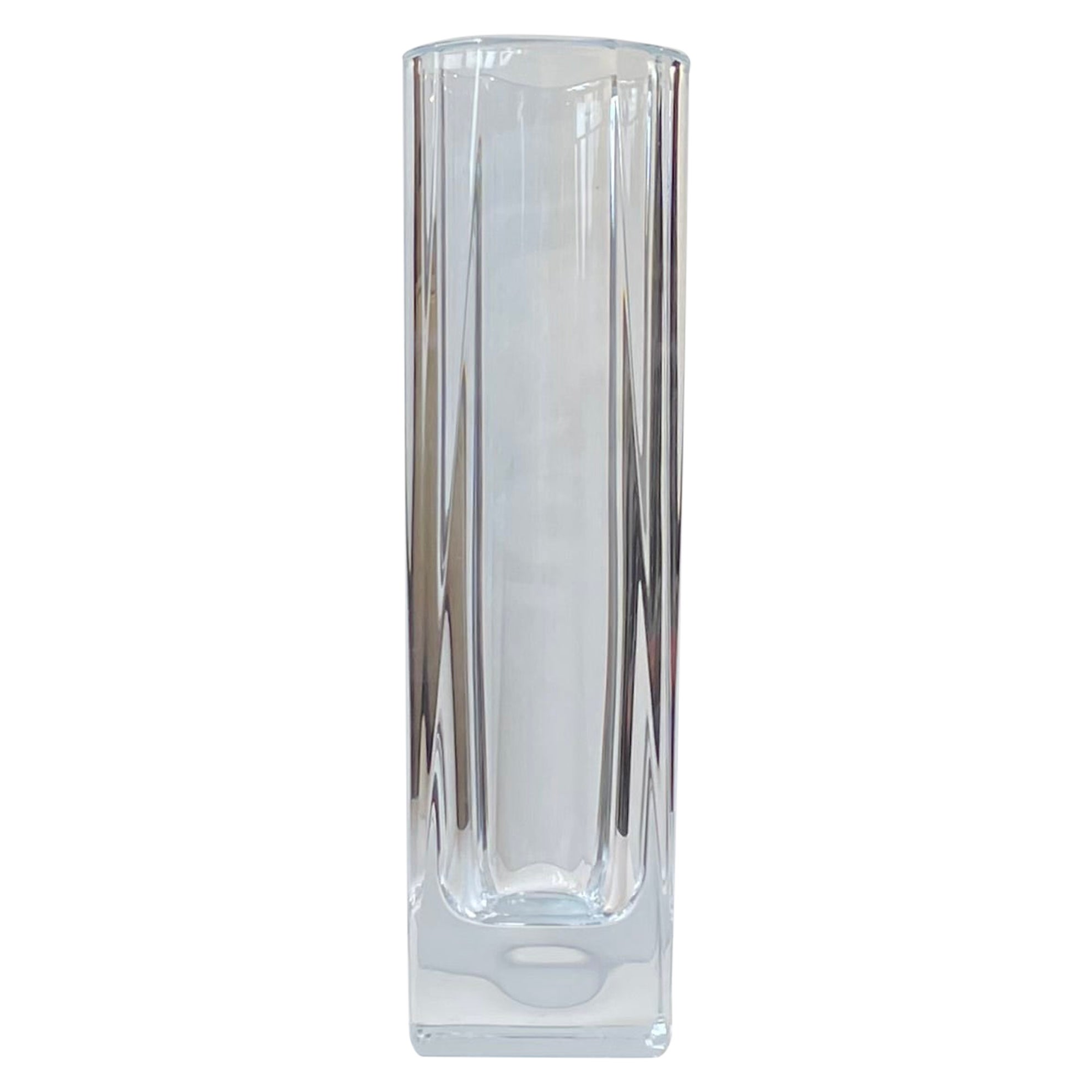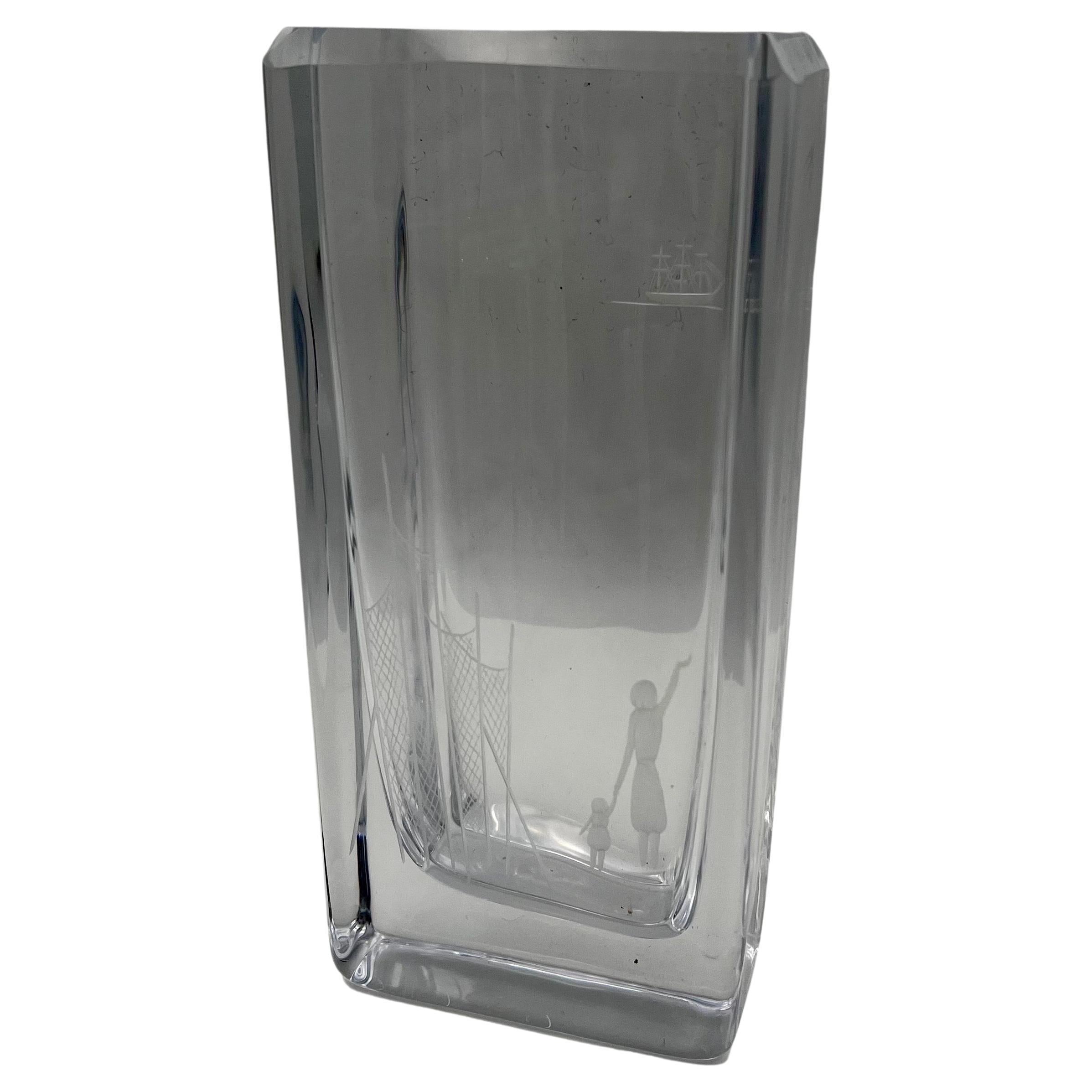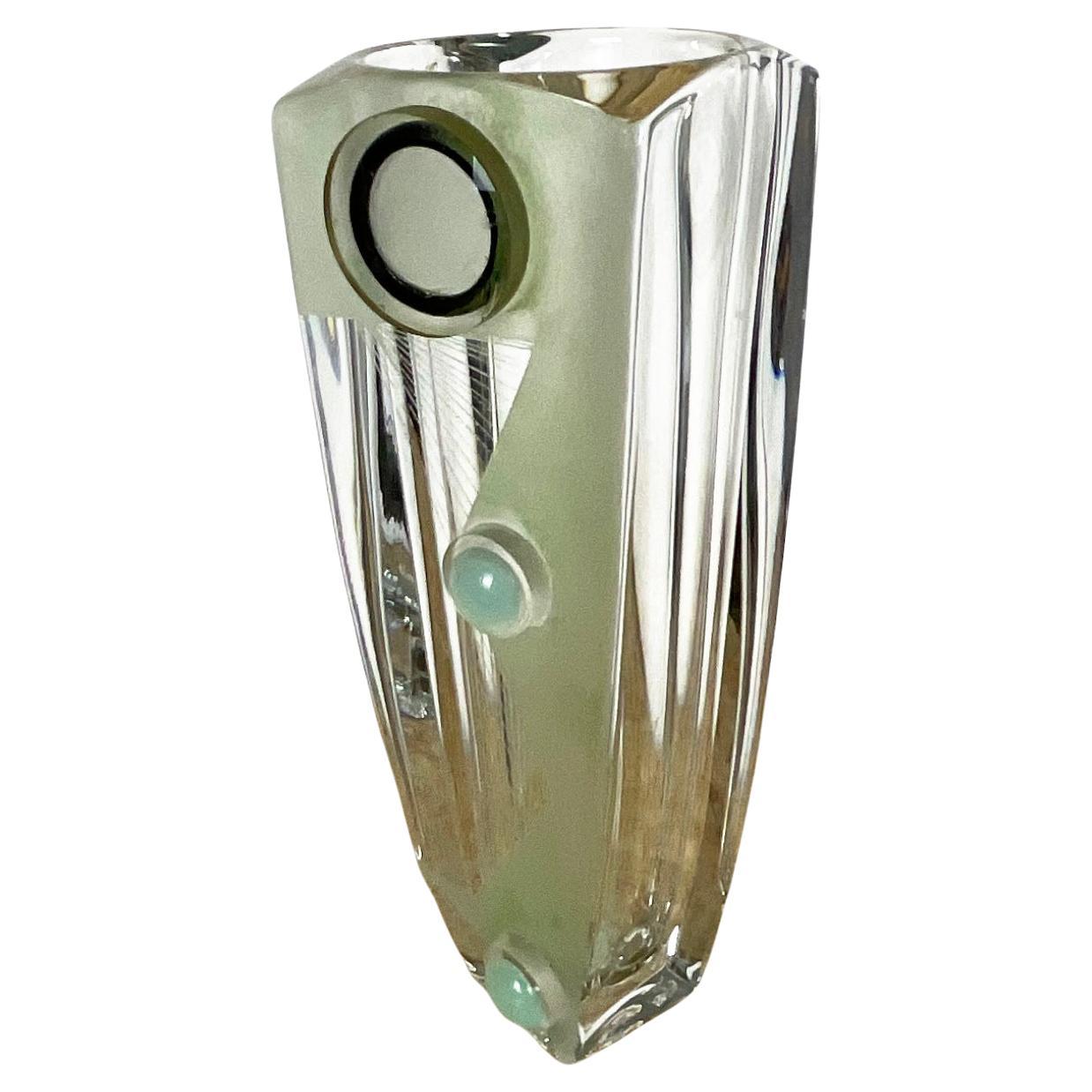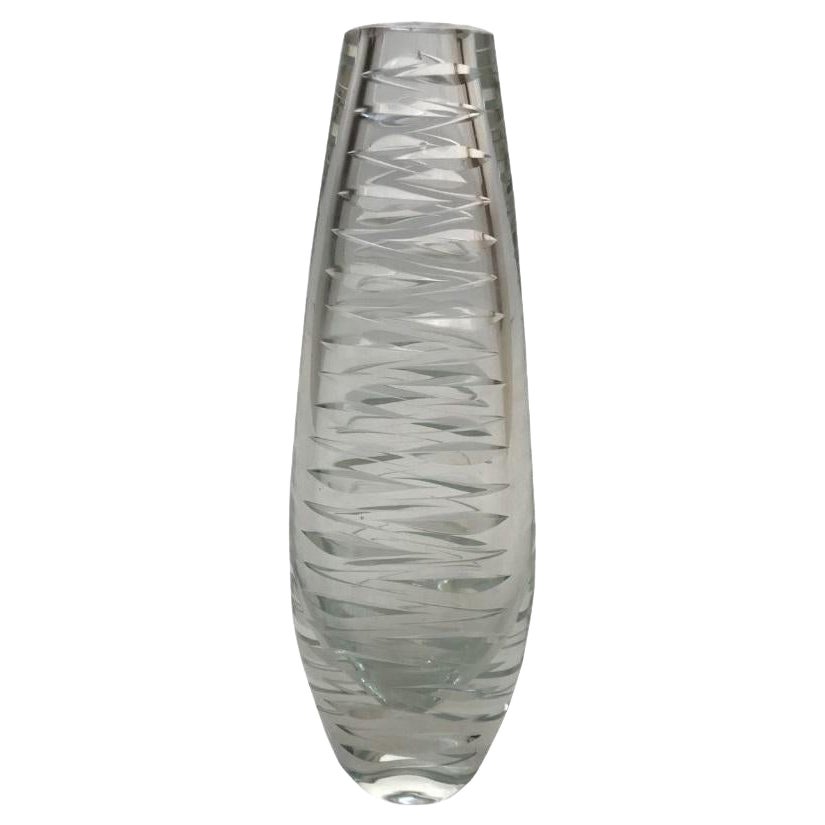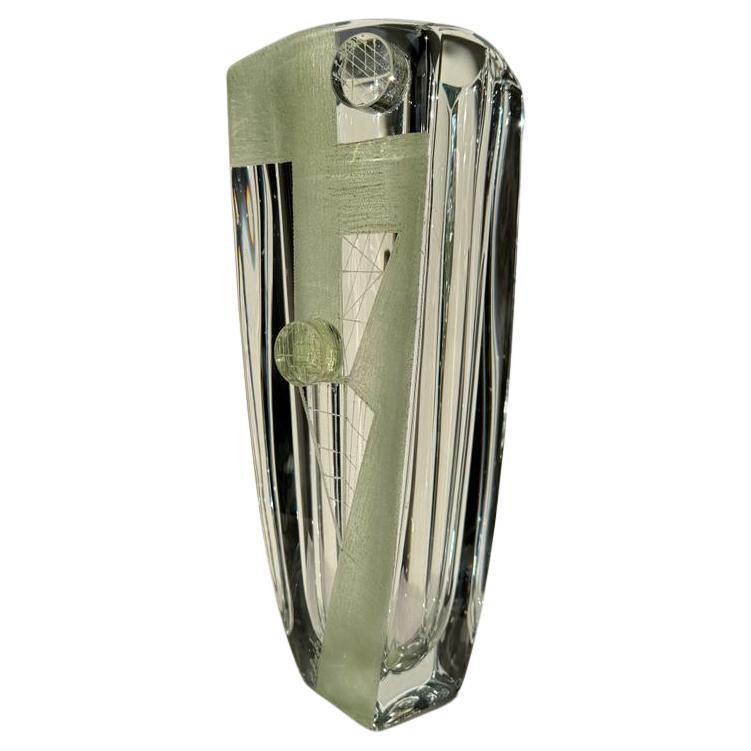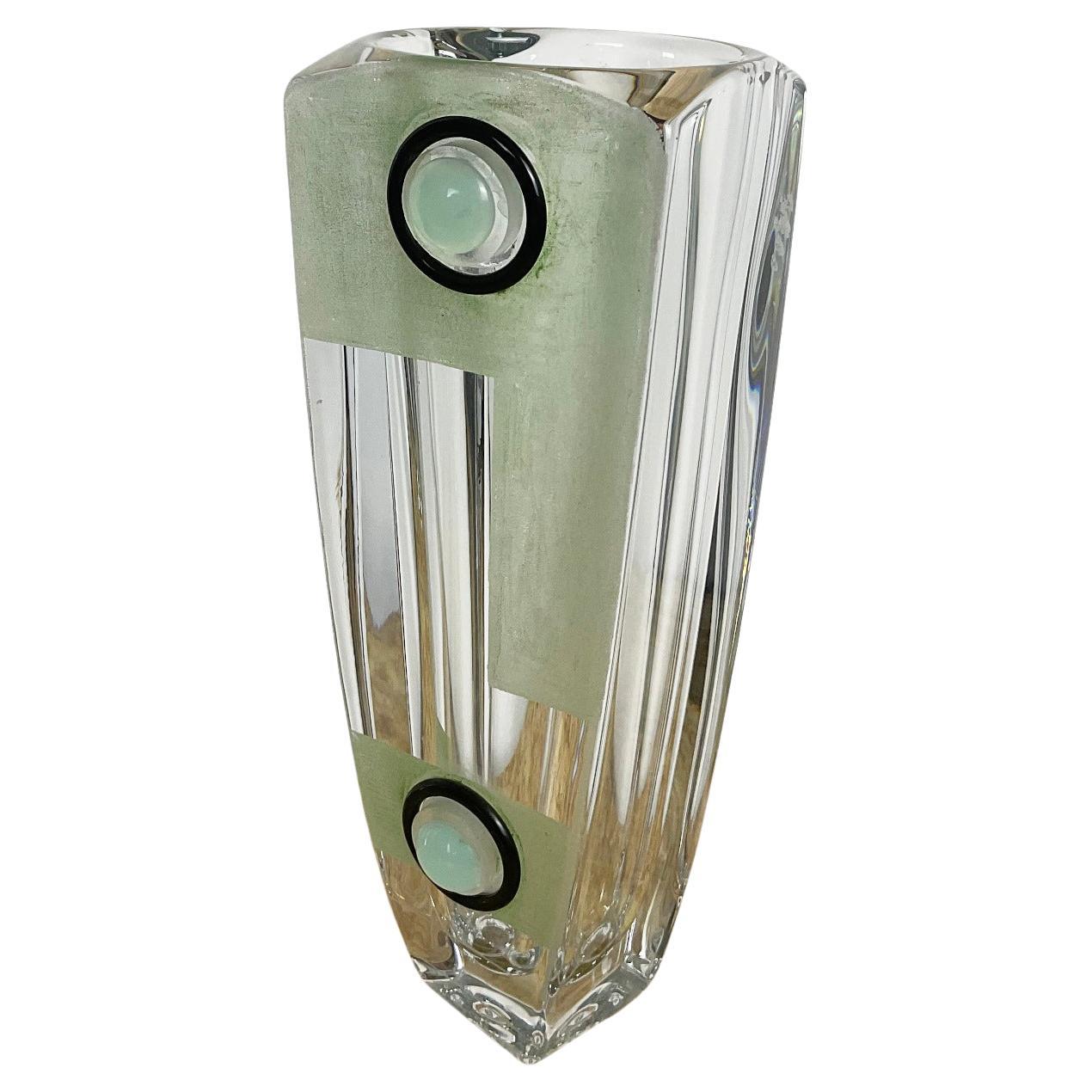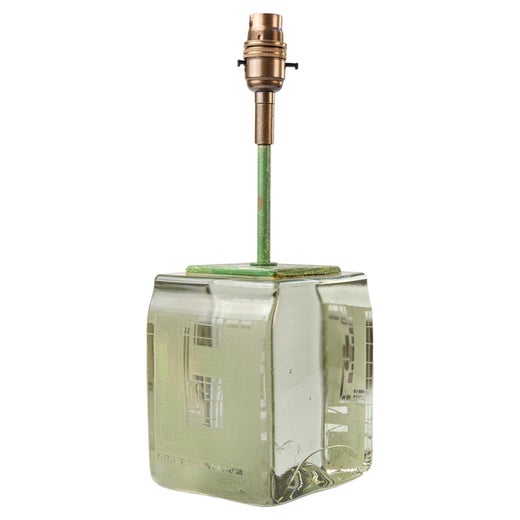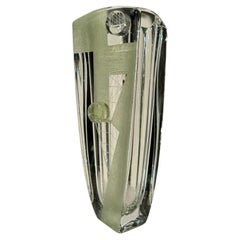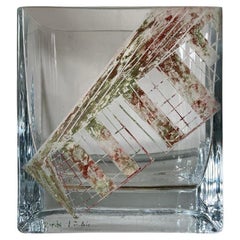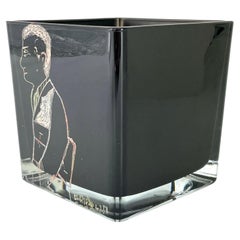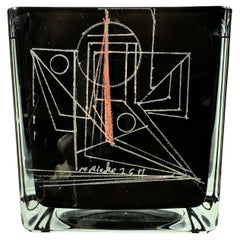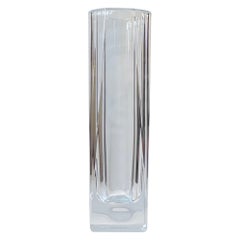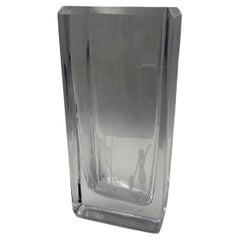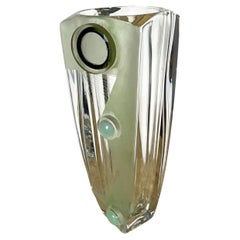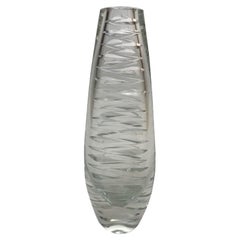Items Similar to Crystal Vase by Anatole Riecke Abstract and Cubist Decor La Coupole Restaurant
Want more images or videos?
Request additional images or videos from the seller
1 of 18
Crystal Vase by Anatole Riecke Abstract and Cubist Decor La Coupole Restaurant
$3,839.79
£2,831.69
€3,200
CA$5,302.71
A$5,818.34
CHF 3,045.05
MX$71,604.03
NOK 38,363.03
SEK 35,932.69
DKK 24,371.93
About the Item
French Crystal vase by Anatole Riecke Decorator of the restaurant La Coupole, Montparnasse Paris. This vase as an Abstract and Cubist Decor created with relief on a twisted crystal vas shape with Green Natural Pigments.
This vase is a creation of the artist Anatole Riecke, of Russian origin, who arrived in Paris in the 1920's.
Anatole Riecke participated in the glass decoration of the famous Parisian restaurant “La Coupole”, symbol of Art Deco architecture, and where all the personalities of the artistic world met.
The twisted shape of the vase gives it strength and originality.
On this crystal vase with variable thicknesses two blocks of translucide glass are juxtaposed on one side decorated with an architectural motif.
Their relief reinforce the strength of this unique glass art piece, decorated with green natural pigments. It's the reminiscence of the art deco period found in this green tone typical of that period.
Unique piece. Signed and dated 1959.
Dimensions: H33xW12cm – Base 6x6cm
Packed with the utmost care.
- Creator:A. Riecke (Artist)
- Dimensions:Height: 13 in (33 cm)Width: 4.73 in (12 cm)Depth: 4.73 in (12 cm)
- Style:Art Deco (In the Style Of)
- Materials and Techniques:
- Place of Origin:
- Period:
- Date of Manufacture:1959
- Condition:In very good condition.
- Seller Location:Crespières, FR
- Reference Number:1stDibs: LU7806238496452
A. Riecke
A. Riecke was a very talented cubist artist who lived and worked in Paris in the early 20th century. His name and date are etched in the glass as part of the decorative detail. Riecke was responsible for the Art Deco glass decor of the restaurant La Coupole.
About the Seller
5.0
Vetted Professional Seller
Every seller passes strict standards for authenticity and reliability
Established in 2011
1stDibs seller since 2022
11 sales on 1stDibs
- ShippingRetrieving quote...Shipping from: Crespières, France
- Return Policy
Authenticity Guarantee
In the unlikely event there’s an issue with an item’s authenticity, contact us within 1 year for a full refund. DetailsMoney-Back Guarantee
If your item is not as described, is damaged in transit, or does not arrive, contact us within 7 days for a full refund. Details24-Hour Cancellation
You have a 24-hour grace period in which to reconsider your purchase, with no questions asked.Vetted Professional Sellers
Our world-class sellers must adhere to strict standards for service and quality, maintaining the integrity of our listings.Price-Match Guarantee
If you find that a seller listed the same item for a lower price elsewhere, we’ll match it.Trusted Global Delivery
Our best-in-class carrier network provides specialized shipping options worldwide, including custom delivery.More From This Seller
View All1950’s French Crystal Vase By Anatole Riecke Transparent And Green
By A. Riecke
Located in Crespières, FR
French Crystal vase by Anatole Riecke – 1950's – white black and silver
This vase is a creation of the artist Anatole Riecke, of Russian origin, who lived in Paris at the beginning ...
Category
Vintage 1950s French Modern Vases
Materials
Crystal
Crystal Vase by Anatole Riecke, Mid Century, La Coupole Restaurant Paris
By A. Riecke
Located in Crespières, FR
French Crystal vase by Anatole Riecke – 1944, La Coupole Restaurant, Paris.
This vase is a creation of the artist Anatole Riecke, of Russian origin, who lived in Paris at the beginn...
Category
Mid-20th Century French Art Deco Vases
Materials
Crystal
Cubic Vase by Anatole Riecke for La Coupole, Representing Jean Gabin, 1958
By A. Riecke
Located in Crespières, FR
Cubic Vase by Anatole Riecke for La Coupole, representing Jean Gabin, 1958
Vase by Anatole Riecke, Cubic, in black opaline, representing Jean Gabin, ...
Category
Vintage 1950s French Mid-Century Modern Vases
Materials
Glass, Art Glass, Opaline Glass
Black Opaline Cubist Vase By Anatole RIECKE, 1959, Abstract Angel
By A. Riecke
Located in Crespières, FR
Black Opaline Cubist Vase by Anatole RIECKE, 1959, Abstract Angel, La Coupole Paris
This vase is a creation of the artist of Russian origin who lived in Paris at the beginning of th...
Category
Vintage 1950s French Art Deco Vases
Materials
Crystal
$587 Sale Price
30% Off
Art Deco French Large Bowl or Centre Piece Bayel Crystal
By Bayel Crystal
Located in Crespières, FR
1920s large fruits, salade, dessert bowl or centre piece in clear transparent crystal.
The Bayel Royal Manufacture was born in 1666, a hundred years before Baccarat, on the request...
Category
Vintage 1920s French Art Deco Candlesticks
Materials
Crystal
Champagne Cristal Glasses, French XIXth Century, More Available
By Baccarat
Located in Crespières, FR
Clear champagne crystal glasse from the XIXth century, a classical model, with a beautiful clear sound.
The facetted decor around catches the light and reflects it even more. The s...
Category
Antique Late 19th Century French Napoleon III Glass
Materials
Crystal
You May Also Like
French Art Deco Cut Crystal Vase in the style of Daum, 1930s
By Daum
Located in Esbjerg, DK
Strictly cut rectangular cristal vase - vastly faceted vertically. Unknown French maker in the style of Daum. No markings. It measures 26.5 cm in height and has a top-width 8x8 cm. I...
Category
Vintage 1930s French Art Deco Vases
Materials
Crystal
$337 Sale Price
25% Off
Artist Signed EtcheBengt Edenfalk Skrufd Crystal Vase Swedish Modern
By Bengt Edenfalk
Located in San Diego, CA
A beautiful signed by crystal Bengt Edenfalk Skruf vase was made in Sweden during the 1970s in a Mid-Century Modern style. excellent condition no chips or cracks, nice etching on bot...
Category
20th Century Swedish Scandinavian Modern Vases
Materials
Crystal
$220 Sale Price
20% Off
1960s Art Deco Crystal Vase Designed by Anatole Riecke
By A. Riecke
Located in London, GB
This vase was designed by Anatole Riecke, a Russian glass artist renowned for his role in the Parisian Art Deco movement. Based in Paris, Riecke became particularly known for his dec...
Category
Vintage 1950s French Art Deco Vases
Materials
Crystal
Vase in Crystal, 1950, France
Located in Ciudad Autónoma Buenos Aires, C
Crystal.
We have specialized in the sale of Art Deco and Art Nouveau and Vintage styles since 1982.
Why are there so many antiques in Argentina?
In the 1880 – 1940 there was a grate wave of immigration encouraged by the periods of war that were taking place.
1st World War took place between 1914 and 1918
2nd World War took place between 1939 and 1945
The immigrants options were New York or Buenos Aires. Tickets were cheap and in Buenos Aires they were welcomed with open arms, as it was a country where everything was still to be done.
Argentina was the country of new opportunities, labour was needed and religious freedom was assured, in many cases the of the family travel first until they were settled and then the rest of the family members join them.
In the immigrant museum “Ellis Island Immigrant Building” in New York you can se the promotional posters of the boats that would take them to a new life.
Between the years 1895 and 1896, Argentina had the highest DGP (gross domestic product) per capita in the world according to the Maddison Historical Statistics index, this situation arose due to the large amount of food being exported to European countries, which were at war.
The Argentinean ships left the port of Buenos Aires with food, but they returned with furniture, clothes and construction elements, (it´s common to see this the old buildings of the historic neighbourhood of San Telmo, the beams with the inscription “Made in England)”, as well as many markets that were built in Buenos Aires, such us the San Telmo Market, whose structure was brought by ship and afterwards assembled in 900 Defensa Street.
With the great influence of European immigrants living in the country, the children of the upper classes travelled to study in France, resulting in the inauguration of “La Maison Argentinienne”, on 27th of June 1928, in the international city of Paris, which hosted many Argentinians that were studying in Frace.
It´s the fourth house to be built after France, Canada and Belgium, being the first Spanish-speaking one. Still in place today (17 Bd Jourdan, 75014, Paris, France). Many of the children of these wealthy families who attended international art exhibitions, museums and art courses abroad, took a keen interest in the European style. This is why Buenos Aires was at the time referred as “The Paris of South America”.
Between the years 1890 and 1920 more than a hundred Palaces were built on Alvear Avenue the most exclusive avenue in Buenos Aires. Today some of these palaces have been transformed into museums, hotels and embassies.
In the year 1936, the Kavanagh building was inaugurated, it was the tallest reinforced concrete building in South America.
During 1994 the American Society of Civil Engineers distinguished it as an “international engineering milestone”, and it´s now considered a World Heritage of Modern Architecture.
At the time was common to hire foreign architects such as Le Corbusier, who visited Buenos Aires/Argentina in 1929 and in 1948 he drew up the blueprints for a house built in La Plata City (which was declared a World Heritage Site).
In 1947, the Hungarian architect Marcelo Breuer designed “Parador Ariston” in the seaside city of Mar del Plata. After an Argentinean student at Harvard University convinced him to come to Argentina. He worked on an urban development project in the Casa Amarilla, area of La Boca.
The Ukrainian architect, Vladimiro Acosta, arrives in Argentina in 1928 and worked as an architect until que moved to Brazil.
Antonio Bonet, a Spanish architect who worked with Le Corbusier in Paris, arrives in Argentina in 1937, where he carried out several architectural works and in 1938 designs the well-known BFK chair.
Andres Kálnay, of Hungarian origin, made around 120 architectural masterpieces, among which the former Munich brewery stands out, he even made the furniture’s design.
The German architect, Walter Gropius, director of the Bauhaus, lived in Argentina, where he wrote articles for “Sur” magazine and founded in Buenos Aires, an architectural firm with Franz Möller, who was also an architect, where he built two houses.
At the same time several famous designers decided to immigrate to Argentina, among them we can find the well-known French designer, Jean-Michel Frank, who arrived in the country in 1940 and also worked for the Rockefeller family.
Special pieces were made, which were sold exclusively in the country, such as the well-known German company “WMF”, who sold their products by catalogue, which were chosen by the ladies of High Society in the list of wedding gifts, as well as the pieces designed by Christofle.
The Swiss sculptor Alberto Giacometti, made special pieces for Argentinean mansions.
In 1904 the first Jansen branch outside Paris was established in Buenos Aires, as the Argentinean clientele demanded a large amount of furniture, from the end of the 19th century to the Mid-20th Century.
In 1970, the brand Rigolleau Argentina made pieces authorised by Lalique.
The brands Maple and Thompson also set up shop in the country.
The French plastic artist, Marcel Duchamp moved to Argentina in 1918-1919.
Glass signed Gallé, Charder, Leverre, Schneider, Muller and other French firms. They were bought in flower shops and were given to ladies with beautiful floral arrangements.
Some furniture manufacturers travelled to international fairs and bough the patterns to produce the furniture in Argentina, such as the furniture firm Englander and Bonta, who bought the patterns ins Italy.
It is worth mentioning that in Argentina we have the largest Community of Italians outside...
Category
Vintage 1940s French Art Deco Vases
Materials
Crystal
Art Deco Engraved Crystal Vase Designed by Anatole Riecke France 1950s
By A. Riecke
Located in London, GB
This vase was designed by Anatole Riecke, a Russian glass artist renowned for his role in the Parisian Art Deco movement. Based in Paris, Riecke became particularly known for his dec...
Category
Vintage 1950s French Art Deco Vases
Materials
Crystal
Italian Craftsmanship Hand-Cut and Hand-Polished Beveled Crystal Vase
Located in Prato, Tuscany
We kindly suggest that you read the entire description, as we aim to provide detailed technical and historical information to guarantee the authenticity of our objects. This exceptio...
Category
Late 20th Century Italian Modern Vases
Materials
Crystal
More Ways To Browse
Restaurant Furniture Used
Vintage Restaurant Furniture
Reminiscence Vintage
Retro Restaurant Furniture
La Coupole
Anatole Riecke
Cornucopia Italian
Flame Vase
Ikora Vase
Japanese Floor Vase
Koi Vase
Louis Majorelle Art Deco Furniture
Rosenthal Studio Line Vase Vintage
Savoy Furniture
Snake Vase
Studio Pottery 21st Century
Vase Gres
White Sculptural Vase
